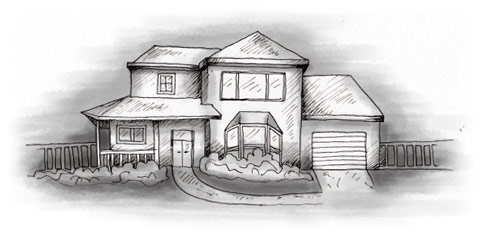An extra few thousand euros spent on a purchase may represent better value for money than spending the money on building work. It’s often cheaper to buy a restored or partly restored property rather than a ruin in need of total restoration, unless you’re going to do most of the work yourself. The price of most restored properties doesn’t reflect the cost and amount of work that went into them and many people who have restored a ‘ruin’ would never do it again and advise others against it.
Before buying a property that needs renovation or restoration, it’s vital to obtain accurate estimates of the work involved from one or more reliable local builders. You should budget for costs to be up to 100 per cent higher than quoted, as it isn’t unusual for the costs to escalate wildly from original estimates.
In general, the Spanish don’t care for old homes and much prefer modern apartments and villas with all mod cons, so it may be more difficult to sell an old property, even if it has been fully renovated.
Checks
It’s vital to check a property for any obvious faults, particularly an old property. Most importantly, a building must have sound walls, without which it may be cheaper to erect a new building! Almost any other problem can be fixed or overcome (at a price). A sound roof that doesn’t leak is desirable, as ensuring that a building is water-proof is the most important priority if funds are scarce. Don’t believe a vendor or agent who tells you that a roof or anything else can be repaired or patched up, but obtain expert advice from a local builder. Sound roof timbers are also important, as they can be expensive to replace.
Old buildings often need a damp-proof course, timber treatment, new windows and doors, a new roof or extensive repairs, a modern kitchen and bathroom, re-wiring and central heating. Electricity and mains water should preferably already be connected, as they can be expensive to extend to a property in a remote area. If a house doesn’t have electricity or mains water, it’s important to check the cost of extending these services to it.
Many rural properties get their water from a spring or well, which is usually fine, but you should check the reliability of the water supply – wells can and do run dry! You should also check the supply available is adequate for your needs. If you’re seeking a waterside property, you should check the frequency of floods and, if commonplace, ensure that a building has been designed with floods in mind, e.g. with electrical installations above flood level and solid tiled floors.
Planning Permission & Building Permits
If modernisation of an old building involves making external alterations, such as building an extension or installing larger windows or new doorways, you need planning permission and a building licence ( licencia de obra) from your local town hall. There are two types of building licence: one for major works ( obra mayor) and another for minor works ( obra menor), depending on the nature and size of the intended construction.
If you plan to do major restoration or building work, you should ensure that a conditional clause is included in the contract stating that the purchase is dependent on obtaining planning and building permission (copies of the applications must be sent to the notario handling the sale). If you apply for a building permit and don’t receive an answer within three months, then it’s automatically approved, if it’s within an urbanisation or a zone already approved for such construction (however, you must apply for a certificate stating that an answer hasn’t been given!). Never start any building work before you have official permission.
When erecting fences or walls, be careful not to take even one centimetre of your neighbour’s land, as property owners are fiercely protective of their boundaries and may make life difficult for you if you ‘overstep the mark’.
If you make major improvements to a property (perhaps to a ruin), you must make a ‘declaration of new work’ ( declaración de obra nueva) when it’s completed, otherwise when you come to sell it you could have a huge capital gains tax bill to pay, as you will be charged capital gains on it as if you had just bought it, even if the improvements were made ten years previously.
DIY or Builders?
One of the first decisions you must make regarding restoration or modernisation is whether to do all or most of the work yourself or have it done by professional builders or local artisans. A working knowledge of Spanish is essential for DIY, especially the words associated with building materials and measurements (renovating a house also greatly improves your ability to swear in Spanish!). When restoring a period property it’s important to have a sensitive approach to restoration. You shouldn’t tackle jobs yourself or with friends unless you’re sure you’re doing them right.
In general, you should aim to retain as many of a building’s original features as possible and stick to local building materials such as wood, stone and tiles, reflecting the style of the property. When renovations and ‘improvements’ have been botched, there’s often little that can be done except to start again from scratch. It’s important not to over-modernise an old property, so that much of its natural rustic charm and attraction is lost.
Even if you intend to do most of the work yourself, you must still hire artisans for certain jobs. It can be difficult to find good artisans, who are in high demand and short supply in some areas. Artisan labour is considerably more expensive and you may find that you must also pay their travelling expenses if your property is remote.
Spanish or Foreign Builders?
When it’s a choice between Spanish and foreign builders, most experts recommend using local labour for a number of excellent reasons. Spanish artisans understand the materials and the traditional style of building, are familiar with local planning and building regulations, and usually do excellent work. If you employ local builders, you can virtually guarantee that the result will be authentic and it could also save you money. Bringing in foreign labour won’t endear you to the local populace and may even create friction.
Nevertheless, finding a Spanish builder can be difficult (see below), finding one who will give you a quote for anything other than a major restoration project even more so, and getting a job done within a set time next to impossible. Communication may also be a problem. There are many excellent foreign builders who have built up a good local reputation and can be relied upon to do a good job within a set period for a competitive price.
You should only employ registered tradesmen and never employ illegal labour (Spanish or foreign): apart from the fact that he won’t be insured, there are stiff penalties for avoiding tax, VAT and social security contributions.
Finding a Builder in Spain
When looking for a builder it’s advisable to obtain recommendations from local people you can trust, e.g. estate agent, surveyor, notario, neighbours and friends. Note, however, that estate agents or other professionals aren’t always the best people to ask, as they may receive commissions. Always obtain references from previous customers.
It may be better to use a local building consortium or contractor rather than a number of independent tradesmen, particularly if you won’t be around to supervise them (although it will cost you a bit more). On the other hand, if you supervise it ‘yourself’ using local hand-picked craftsmen, you can save money and learn a great deal. Always obtain references before employing a builder.
Supervision
If you aren’t able to supervise work, you should hire a ‘clerk of works’ such as an architectural engineer ( aparejador) to oversee a large job, otherwise it could drag on for months (or years) or be left half-finished. This adds around 10 per cent to the total bill, but it’s usually worth it. Be extremely careful who you employ if you have work done in your absence and ensure that your instructions are accurate in every detail.
Always make certain that you understand exactly what has been agreed and, if necessary, get it in writing (with drawings). It isn’t unusual for foreign owners to receive huge bills for work done in their absence that shouldn’t have been done at all! If you don’t speak Spanish it’s even more important to employ someone to oversee building works. Progressing on sign language and a few words of Spanish is a recipe for disaster!
Quotations
Before buying a home for restoration or modernisation, it’s essential to get an accurate estimate of the work and costs involved. You should obtain written estimates ( presupuestos) from at least two builders before employing anyone. For quotations to be accurate, you must detail exactly the work required, e.g. for electrical work this would include the number of lights, points and switches, and the quality of materials to be used.
If you have only a vague idea of what you want, you will receive a vague and unreliable quotation. Make sure that a quotation includes everything you want done and that you fully understand it (if you don’t, get it translated). You should fix a date for the start and completion of work, and if you can get a builder to agree to it, include a penalty for failing to finish on time. After signing a contract it’s usual to pay a deposit, the amount of which depends on the size and cost of a job.
It can be difficult obtaining a detailed written quote from plumbers, electricians and small builders, as they aren’t used to being asked to provide written quotations, especially on the Costas. However, their verbal quotations are usually accurate.
Cost
All building work such as electrical work, masonry and plumbing is priced by the square metre (m2) or metre. The cost of restoration depends on the type of work involved, the quality of materials used and the region. As a rough guide you should expect the cost of totally renovating an old ‘habitable’ building to be at least equal to its purchase price and possibly much more. Some estimates calculate the cost of restoring or rebuilding a large finca to be in the region of e450,000 to e1.5m!
How much you spend on restoring a property depends on your purpose and the depth of your pockets. If you’re restoring a property as an investment, it’s easy to spend more than you could ever hope to recoup when you sell it. Always keep an eye on your budget (it’s very easy to overspend) and don’t be in too much of a hurry. Some people take many years to restore a holiday home, particularly when they’re doing most of the work themselves. It isn’t unusual for buyers to embark on a grandiose renovation scheme, only to run out of money before it’s completed and be forced to sell at a huge loss.
This article is an extract from Buying a home in Spain. Click here to get a copy now.


